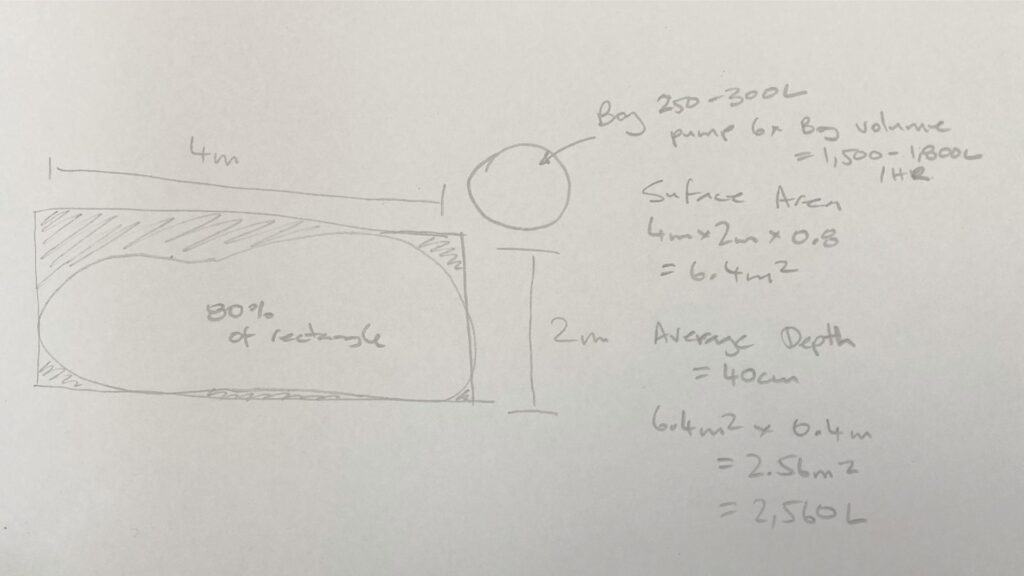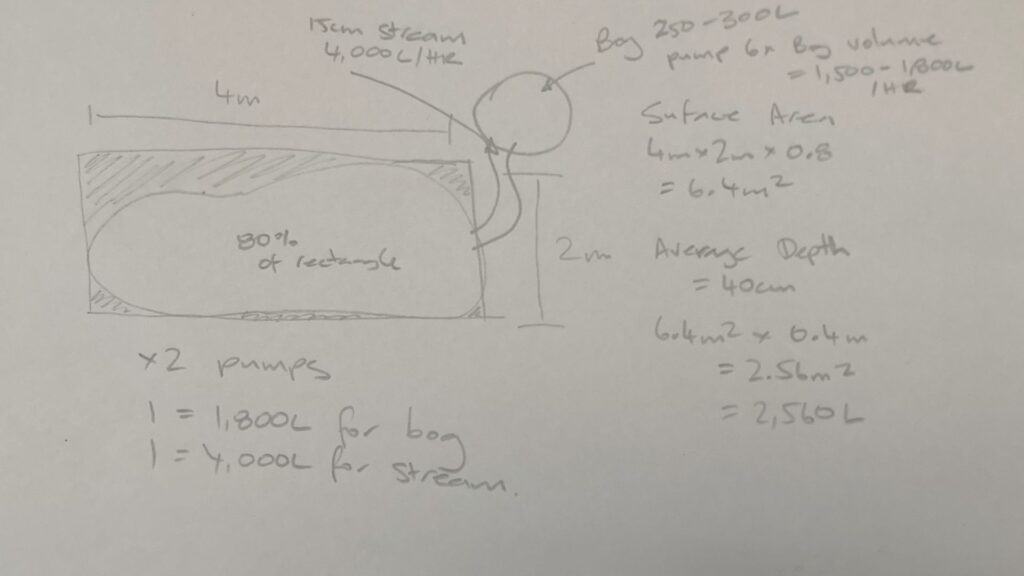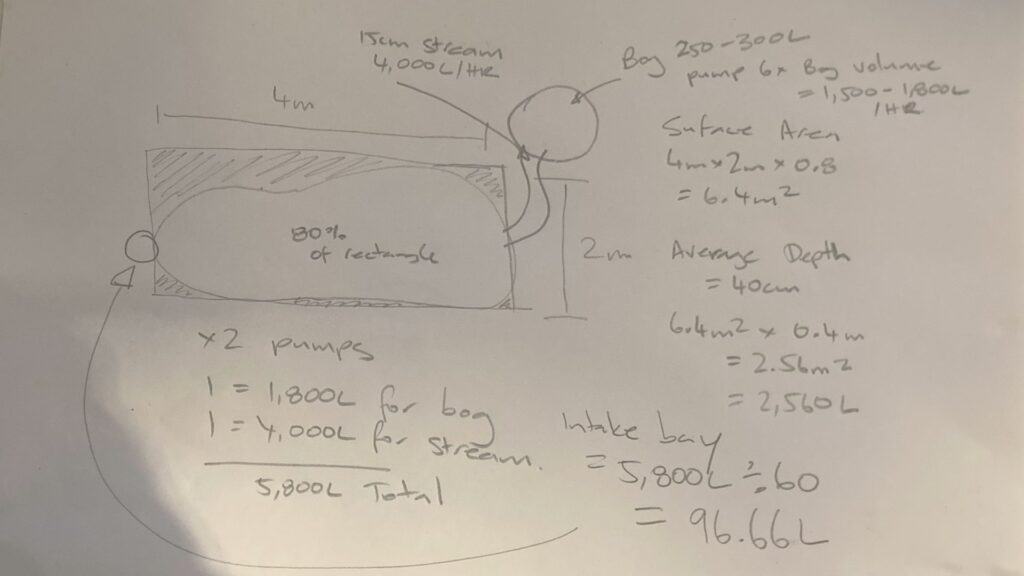In this post and accompanying video, I’ll take you through the basic steps involved in planning and building your very own backyard ecosystem pond complete with an intake bay and a bog filter.
Whether you’re a beginner or a seasoned DIY enthusiast, I’ll show you how to size the filters and pumps to design a pond of any size. So, let’s dive in!
Understanding Ecosystem Ponds, Bog Filters, and Intake Bays
An ecosystem pond is a harmonious blend of rocks, pebbles, and plants, working together to create a self-sustaining aquatic environment. By emulating nature, these ponds require minimal maintenance and provide a natural and serene aesthetic.
The heart of an ecosystem pond is the bog filter, which replicates nature’s filtration process. It utilises layers of rocks, pebbles, and plants to remove impurities and promote a healthy aquatic ecosystem.
Additionally, an intake bay acts as the entry point for water into the filtration system, ensuring a clean and debris-free surface. It will also protect and hide the pumps.
Sizing Your Filters and Pumps
Before embarking on the pond construction, it’s essential to calculate the appropriate sizes for your filters and pumps based on the volume of your pond.
To determine the volume, measure the longest and widest parts of your pond, and create a box or rectangle that encompasses its shape. Estimate the percentage of the box or rectangle occupied by the pond to obtain an approximation of the pond’s surface area.
Next, estimate the average depth of the pond, and multiply it by the surface area to calculate the estimated volume in cubic meters or feet.

To convert to litres, remember that one cubic meter (35.315 cubic feet) equals one thousand litres (264.172 US liquid gallons).
When selecting the size of your bog filter, it’s generally recommended to aim for 10% of the pond’s volume for goldfish, 15-20% for koi, and 25% or more if you plan to swim in the pond. This ensures effective filtration and optimal water clarity.

In this example, the pond is for goldfish, therefore the bog is around 10% of the estimated pond volume. As for the pump, a good rule of thumb is to size it at six times the volume of the bog filter.
For larger ponds, adjustments may be necessary, often on larger bodies of water I will choose less circulation to save on energy use. Larger bodies of water tend to be more stable and therefore require less moving water.
Adding Waterfalls and Streams
If you desire the soothing sound of cascading water and the beauty of flowing streams in your pond, you’ll need to consider the additional water volume required.
As a general guideline, a 30 cm (12in) wide waterfall typically necessitates a water flow rate between 8,000 (2113 gal) and 12,000 (3170 gal) litres per hour. Adjust the flow rate according to your desired waterfall size, using half the flow for half the width and double the flow for double the width, you get the idea.
To accommodate the increased flow, you have two options. You can use two pumps, one dedicated to the bog filter and another for the stream, or you can use one pump and regulate the water distribution using a regulator valve.

On this example I want to have a 15cm (6in) wide stream, that means I require a flow rate of between 4000- 6000 litres (1056-1585 gal) per hour. In this example I choose 4000 litres (1056 gal).
So now that I know the flow rate on my stream/ waterfall and I know the flow rate for my bog filter I can size my pumps. On this example I am going to keep it simple and run 2 pumps. One at 1800 litres (475 gal) for the bog, and one at 4000 (1056 gal) for the stream.
Sizing the Intake Bay
The size of the intake bay, where the pumps are housed, should be determined by the total pumping capacity.
A general rule is to design the intake bay to accommodate one minute’s worth of pumping. Simply divide the pumping volume by 60 to obtain the required size.

So if we again look at this example, my total pumping capacity is 5800 litres (1532 gal), therefore the intake bay should hold that number, divided by 60 (to give us the one minute worth of water number).
Therefore my intake bay needs to hold 96.66 litres, I would simply round that up to 100 litres (26 gal)
Putting It All Together
Once you have determined the total water volume and the appropriate sizes for your filters and pumps, it’s time to plan the liner, select filtration media, and choose energy-efficient pumps.
For the liner, measure the dimensions of your pond, adding extra material to account for overlaps and folds. Consider using EPDM rubber liners (Amazon link), which are durable and flexible.
When selecting filtration media, opt for high-quality rocks and pebbles that provide ample surface area for beneficial bacteria to thrive.
As for the pumps (Amazon link), I recommend low volt sine wave pumps for their efficiency and performance.
This other video will help show how all the components come together during the building phase.
Conclusion
Building your own backyard ecosystem pond can be a rewarding and enjoyable experience. By following the steps I’ve outlined, you’ll have the knowledge and confidence to create a stunning pond that not only enhances the beauty of your outdoor space but also nurtures a thriving aquatic ecosystem.
If you need further information or insights my downloadable PDF only costs $10AUD (about $6.60 US at time of writing), it includes things like: how to calculate water in motion, plumbing sizes, amount of liner, rock, etc. It also has the formulas I’ve shared with you in this article and video.
I hope you found this helpful.

